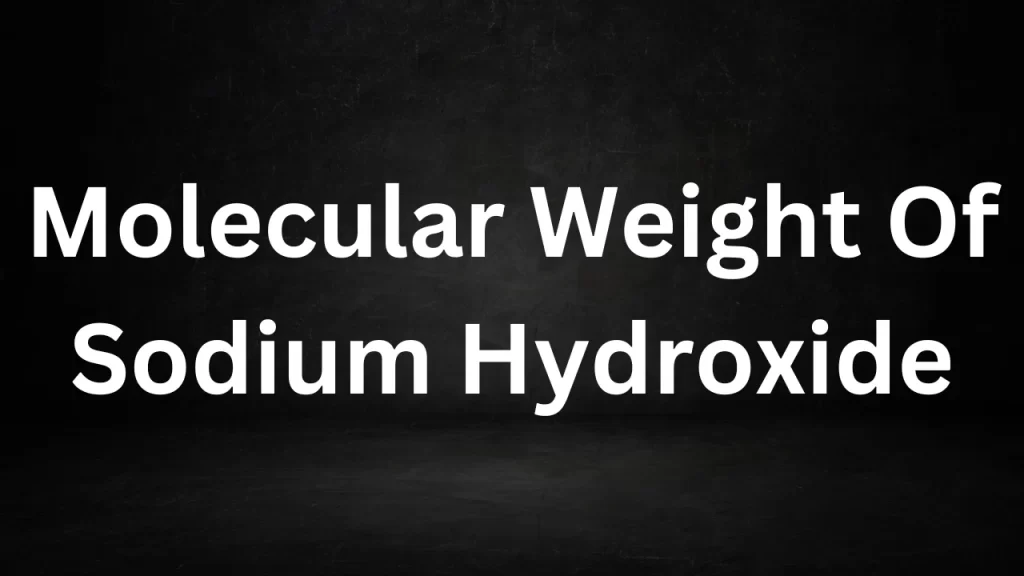Tag: caustic molecular weight
Molecular Weight Of Sodium Hydroxide
Molecular Weight Of Sodium Hydroxide: When it comes to understanding the properties and behavior of chemicals, one fundamental concept that chemists rely on is the molecular weight.
The molecular weight, often referred to as the molar mass or molecular mass, is a crucial parameter in chemistry that provides insights into the composition of a compound. In this article, we will explore the molecular weight of sodium hydroxide (NaOH), a common and important chemical compound.

Molecular Weight Of Sodium Hydroxide
Sodium Hydroxide (NaOH): The Basics
Before delving into the molecular weight of sodium hydroxide, let’s familiarize ourselves with this compound. Sodium hydroxide, with the chemical formula NaOH, is an inorganic compound that plays a significant role in various industries, including chemical manufacturing, water treatment, and the production of soaps and detergents. It is frequently referred to as caustic soda or lye.
Sodium hydroxide is a white, solid substance at room temperature and is highly soluble in water. It is known for its strong alkaline properties and is classified as a strong base. When dissolved in water, it dissociates into its constituent ions, sodium ions (Na⁺) and hydroxide ions (OH⁻). This dissociation is crucial to understanding its molecular weight.
Calculating the Molecular Weight
The molecular weight of a compound is ascertained by summing the atomic weights of all the constituent atoms within a single molecule of that compound. In the case of sodium hydroxide (NaOH), we have three elements: sodium (Na), oxygen (O), and hydrogen (H).
Let’s break down the atomic weights of these elements:
- Sodium (Na) has an atomic weight of approximately 22.99 grams per mole.
- Oxygen (O) has an atomic weight of approximately 15.999 grams per mole.
- Hydrogen (H) has an atomic weight of approximately 1.008 grams per mole.
To calculate the molecular weight of sodium hydroxide, we sum the atomic weights:
Molecular Weight (NaOH) = Atomic Weight(Na) + Atomic Weight(O) + Atomic Weight(H) Molecular Weight (NaOH) = 22.99 g/mol + 15.999 g/mol + 1.008 g/mol
Molecular Weight (NaOH) ≈ 39.997 g/mol
So, the molecular weight of sodium hydroxide (NaOH) is approximately 39.997 grams per mole.
Significance of Molecular Weight
Understanding the molecular weight of a compound is vital in various aspects of chemistry and science. Here are some key reasons why it’s important:
- Stoichiometry: Molecular weight is essential in balancing chemical equations and determining the quantitative relationships between reactants and products in chemical reactions.
- Concentration Calculations: It helps in calculating the concentration of a substance in a solution, which is crucial in analytical chemistry and laboratory work.
- It serves as a fundamental factor utilized in various chemical computations, encompassing stoichiometry, concentration determination, and molar mass calculations.
- Physical Properties: Molecular weight influences the physical properties of a compound, such as its melting point, boiling point, and density.
In conclusion, the mole weight of sodium hydroxide (NaOH) is approximately 39.997 grams per mole. This value is a fundamental piece of information that aids chemists and scientists in their work, from conducting chemical reactions to formulating solutions and understanding the behavior of this important compound in various applications. Sodium hydroxide’s molecular weight serves as a building block for deeper insights into its chemical properties and its role in diverse industrial processes.
Read More
- Molecular Weight Of Aluminium
- Molecular Weight Of CaCl2
- Molecular Weight Of Copper
- Molecular Mass Of Ethanol
- Molecular Mass of Ammonia
Frequently Asked Questions (FAQs) Molecular Weight Of Sodium Hydroxide
1. What is the molecular weight of sodium hydroxide (NaOH)?
The mole weight of sodium hydroxide (NaOH) is approximately 39.997 grams per mole.
2. Why is it important to know the molecular weight of sodium hydroxide?
Knowing the mole weight of sodium hydroxide is essential in chemistry as it helps chemists understand the composition of the compound. It serves as a fundamental factor utilized in various chemical computations, encompassing stoichiometry, concentration determination, and molar mass calculations.
3. What is sodium hydroxide (NaOH), and where is it commonly used?
Sodium hydroxide, chemically denoted as NaOH, is an inorganic substance widely acknowledged as caustic soda or lye. This highly alkaline compound sees extensive application in chemical manufacturing, water treatment, the manufacturing of soaps and detergents, and various industrial processes.
4. How is the molecular weight of sodium hydroxide calculated?
To determine the mole weight of sodium hydroxide (NaOH), one simply sums the atomic weights of its component elements: sodium (Na), oxygen (O), and hydrogen (H). For NaOH, the calculation is straightforward:
Molecular Weight (NaOH) = Atomic Weight(Na) + Atomic Weight(O) + Atomic Weight(H)
The Molecular Weight (NaOH) = 22.99 g/mol + 15.999 g/mol + 1.008 g/mol
Molecular Weight (NaOH) ≈ 39.997 g/mol
5. What are the practical applications of understanding the molecular weight of sodium hydroxide?
Understanding the mole weight of sodium hydroxide is crucial in a wide range of chemical and industrial processes. It finds application in establishing reaction stoichiometry, computing concentrations within solutions, determining molar masses, and making predictions regarding the physical characteristics of the compound.
Molecular Mass Of Naoh
Molecular Mass Of Naoh: Sodium hydroxide, commonly known as NaOH, is a chemical compound with a significant presence in various industrial and household applications.
Understanding the molecular mass of NaOH is fundamental to comprehend its properties and applications in chemistry, manufacturing, and everyday life.

Molecular Mass Of Naoh
The Basics of Molecular Mass
Molecular mass, also referred to as molecular weight or molar mass, is a critical concept in chemistry. It represents the mass of a molecule and is expressed in atomic mass units (u) or unified atomic mass units (AMU). Molecular mass is calculated by summing the atomic masses of all the atoms present in a molecule.
Composition of NaOH (Sodium Hydroxide)
NaOH, or sodium hydroxide, consists of three elements: sodium (Na), oxygen (O), and hydrogen (H). To determine its molecular mass, we need to consider the individual atomic masses of these elements.
- The atomic mass of sodium (Na) is approximately 22.98977 u.
- The atomic mass of oxygen (O) is approximately 15.999 u.
- The atomic mass of hydrogen (H) is approximately 1.00784 u.
Calculating the Molecular Mass of NaOH
To find the molecular mass of sodium hydroxide, we simply add the atomic masses of its constituent elements:
Molecular Mass of sodium hydroxide = (Atomic Mass of Na) + (Atomic Mass of O) + (Atomic Mass of H) Molecular Mass of sodium hydroxide ≈ 22.98977 u + 15.999 u + 1.00784 u ≈ 39.99661 u
Rounded to four decimal places, the molecular mass of sodium hydroxide is approximately 39.9966 atomic mass units (u).
Significance of NaOH’s Molecular Mass
Understanding the molecular mass of sodium hydroxide has several practical implications:
- Chemical Reactions: In chemical reactions involving sodium hydroxide, its molecular mass is crucial for stoichiometry calculations. It helps determine the amount of NaOH required or produced in a chemical reaction.
- Manufacturing and Industry: sodium hydroxide is a versatile industrial chemical used in processes such as soap and detergent production, paper manufacturing, and water treatment. Knowing its molecular mass is vital for precise formulation.
- Laboratory Work: In laboratory settings, scientists and researchers use the molecular mass of NaOH to accurately prepare solutions and calculate concentrations.
- Environmental Considerations: NaOH plays a role in wastewater treatment and pH adjustment. Understanding its molecular mass aids in controlling and optimizing these processes.
- Household Use: In households, NaOH is commonly found in drain cleaners and oven cleaners. Knowledge of its molecular mass is not only important for product efficacy but also for safety precautions.
- Conclusion
- The molecular mass of NaOH (sodium hydroxide), approximately 39.9966 atomic mass units (u), is a fundamental property of this essential chemical compound. It underpins its applications in various industries, chemical processes, and everyday products. Whether you’re a chemist, an industrial engineer, or simply someone using household cleaning products, an awareness of NaOH’s molecular mass is indispensable for understanding its role in numerous aspects of our lives.
Read More
- Molecular Mass Of Nitrogen
- Molecular Weight Of Glucose
- Molecular Mass Of Oxygen
- Difference Between Light Microscope And Electron Microscope
- Molar Mass Of Aluminium
Frequently Asked Questions (FAQs) Molecular Mass Of Naoh
1. What is the molecular mass of NaOH (sodium hydroxide)?
The molecular mass of NaOH, also known as sodium hydroxide, is approximately 39.9966 atomic mass units (u). This value is obtained by summing the atomic masses of the constituent elements in the compound: sodium (Na), oxygen (O), and hydrogen (H).
2. Why is it important to know the molecular mass of NaOH?
Understanding the molecular mass of sodium hydroxide is essential in various scientific, industrial, and practical applications. It aids in determining reactant and product quantities in chemical reactions, formulating solutions, and controlling processes in industries like manufacturing and wastewater treatment.
3. How is the molecular mass of NaOH calculated?
The molecular mass of sodium hydroxide is calculated by adding the atomic masses of its constituent elements, namely sodium (Na), oxygen (O), and hydrogen (H). The atomic masses can be found in the periodic table, and their sum gives the molecular mass of NaOH.
4. What are the common uses of NaOH in everyday life and industry?
Sodium hydroxide is a versatile chemical compound used in various applications, including soap and detergent production, paper manufacturing, water treatment, and household cleaning products like drain cleaners and oven cleaners.
5. Is NaOH’s molecular mass relevant in chemical reactions?
Yes, NaOH’s molecular mass is crucial in chemical reactions where it serves as a reactant or product. It helps chemists determine the stoichiometry of reactions and calculate the amounts of substances involved.